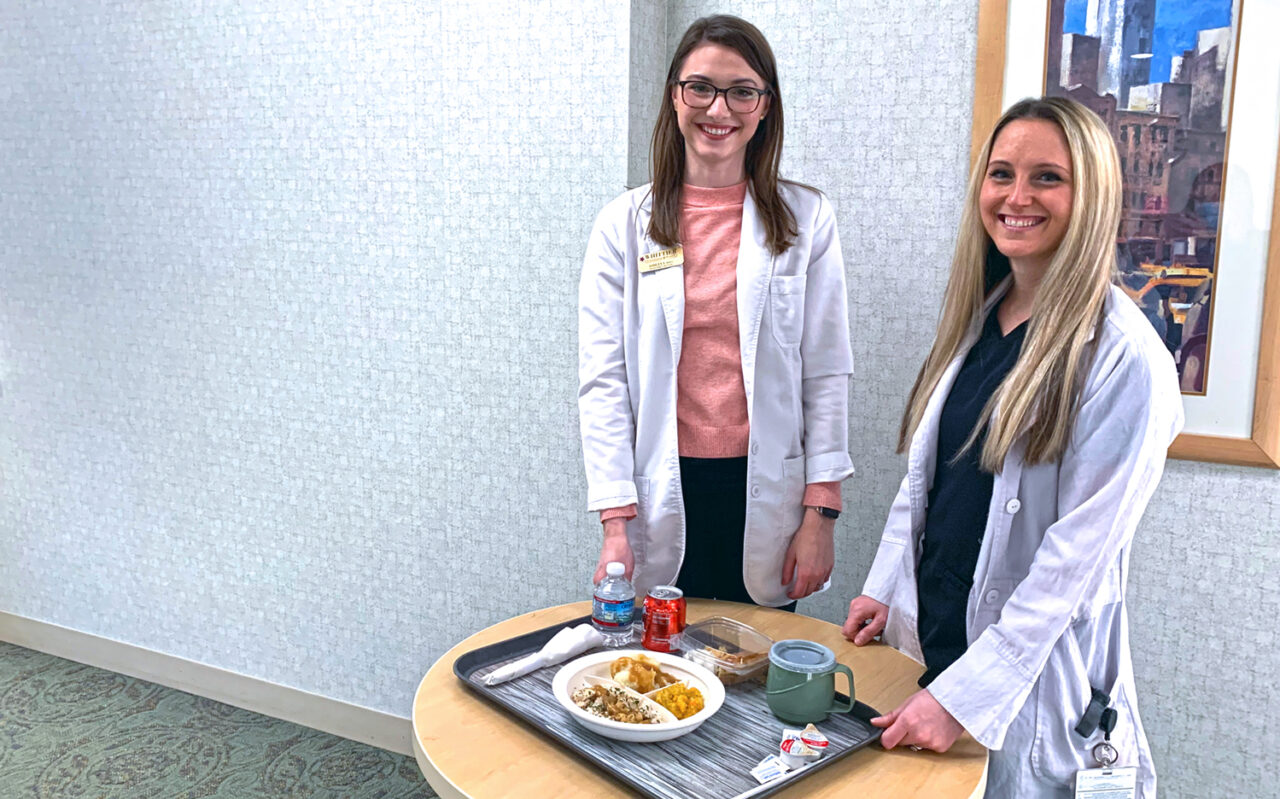Speech-Language Pathologist Holly Sylvestre, MS CCC-SLP and Dietitian Ashley Iannaco, RD, LDN met with us recently to talk about their different roles and to explain how they collaborate to meet the nutritional needs of the patients under their care at Whittier Rehabilitation Hospital Bradford. They also describe modified diets: what they are and how they help to make eating and drinking more comfortable, more enjoyable, and much safer for the patient.
Speech Therapy Diet Education Q & A
What is the difference between a Speech-Language Pathologist (SLP) and a Dietitian (RD)?
Although SLPs and RDs work very closely together, they do have different roles. A SLP’s role is to assess and recommend the least restrictive and safest diet texture for the patient as well as help facilitate the rehabilitation of their swallowing. A Dietitian’s role is to estimate nutritional needs for patients and to work towards ensuring that these needs are being met. Sometimes, if a patient is recommended a modified diet, they may not eat as well as they did on a regular texture diet. Dietitians work with the patients to help them meet their energy needs by recommending oral nutrition supplements or by helping them find foods that they enjoy within their recommended prescribed texture.
Why is a Dietitian important in a rehabilitation facility?
A Registered Dietitian (RD) is integral in a rehabilitation facility because many patients that come to the hospital can be at risk for malnutrition, either due to inadequate energy intake or to prolonged illness which increases the metabolic rate and therefore their energy requirements. An RD assesses the calorie and protein needs of each patient and works with them to provide individualized nutrition care plans and recommendations.
How do an SLP and a Dietitian (RD) work together?
An SLP and an RD work together in the sense that they both have the same goal—for a patient to achieve their nutritional and hydration goals, while consuming the safest and least restrictive diet. Though an SLP recommends the appropriate texture and consistency of the food and drink, the RD works with the patient and family to find foods within the recommended texture that the patient finds appealing to help them meet their energy needs. Oftentimes the SLP and the RD will collaborate about the patient’s progress. The SLP will alert the RD if a patient is having sub-optimal oral intake and the RD can alert the SLP if a patient complains of difficulty swallowing. Each plays an integral part in the success of the patient’s overall nutritional status and rehabilitation.
As Holly Sylvestre says: “Our team collaboration at Bradford is really incredible, between all disciplines, unlike any other place I’ve worked in. I feel that the respect that we get, specifically as an SLP and RD, from the medical staff is huge. It doesn’t happen at other facilities – they really respect our expertise, value our opinions, they come to us, I think that’s a big thing here at Bradford.”
Why a patient needs a modified diet – due to dysphagia
What is dysphagia? Dysphagia is the medical term for difficulty swallowing. This can occur at one or multiple stages in the swallowing process and can occur with foods, liquids, or saliva.
What can cause dysphagia? There are many different reasons a person can develop dysphagia. Some examples can include: neurological injuries such as stroke, multiple sclerosis, ALS, TBI, Parkinson’s Disease etc. Other common etiologies can include but are not limited to head and neck cancer, injuries to the throat, intubation, and poor dentition or lack of teeth. Therefore, these people cannot safely consume all textures of foods.
How do we evaluate/determine if someone has dysphagia? The doctor consults a Speech-Language Pathologist (SLP) by writing an order.
We (SLP) then evaluate the patient at the bedside, consuming different diet textures, to assess their tolerance/safety. We may modify the textures if the patient is demonstrating difficulty by showing signs or symptoms of aspiration (ie: coughing, wet voice, throat clearing etc.). We may, as well, assess the movement of their oral structures.
If we are unable to determine what texture is safest at that time, we may recommend a modified barium swallow study (MBS), which is a video x-ray of a patient swallowing different textures of foods and liquids. From this study, the SLP determines which phase of swallow is impaired and creates a plan of care to rehabilitate those muscles as well as recommend the safest diet to help prevent aspiration (passage of food and/or liquid into the lungs).
What are the stages of swallowing? There are 3 stages of swallowing: oral, pharyngeal, and esophageal.
- The oral phase of swallowing is the first stage, and it is a voluntary process. This phase includes your lips closing to make a seal around a cup or utensil, mastication (chewing), and breaking down the food by mixing it with saliva to form a bolus to be propelled to the back of your mouth to be swallowed.
- The pharyngeal phase is the second stage of swallowing and, unlike the oral phase, it is involuntary. This is a complex process that includes the act of swallowing foods, liquids, saliva, and medications. For this phase to be successful, the nasal cavity is sealed when the soft palate raises (that prevents food/fluid coming out of the nose), the larynx (voice box) moves upwards and forward, the vocal folds close, and then the epiglottis closes over the airway (breathing stops momentarily). The pharynx pushes the bolus down (by contracting in a stripping motion) to the upper esophageal sphincter which opens to allow the bolus through.
- The esophageal phase is the third phase of swallowing and is also involuntary. This phase includes the food and/or liquid bolus being transported through the esophagus by wavelike muscular contractions (peristalsis) into the stomach. The lower esophageal sphincter opens to allow the bolus into the stomach and closes after the bolus has passed through (to prevent reflux / regurgitation).
What is a modified diet and why would it be recommended?
A modified diet is recommended by an SLP when a patient has difficulty swallowing foods and/or liquids. There are various types of modified diets and are determined based on the phase of swallow that is impaired. Some modified diets may only be temporarily recommended until it is deemed safe to swallow advanced diet textures while working with an SLP to create an individualized plan to help rehabilitate their swallowing.
Modified diets are recommended to prevent or decrease the risk of aspiration of food and/or liquids which can develop into aspiration pneumonia, worsening respiratory status, and even death.
Why might a therapeutic diet be recommended?
Based on a patient’s medical history, a therapeutic diet is recommended to help improve the health of a patient. For example, a person with diabetes might be recommended to follow a Consistent Carbohydrate diet to help control blood glucose levels. A patient with Congestive Heart Failure might be recommended to follow a low sodium diet to help manage the amount of edema or swelling that they might have. An RD can provide diet education to help a patient and family understand the therapeutic diet and to put the recommendation into action – both at home and while in the hospital – to ideally prevent readmission and to improve their quality of life.
What types of modified diets do we offer at Whittier?
Whittier’s liquid consistencies include the following:
i. Thin liquids
ii. Mildly thick liquids (nectar-like consistency)
iii. Moderately thick liquids (honey-like consistency)
iv. Extremely thick liquids (pudding-like consistency)
Whittier’s solid consistencies include the following:
v. Puree solids (everything is smooth like applesauce)
vi. Moist ground solids (everything is ground up like cottage cheese or scrambled eggs)
vii. Mechanical soft cut solids (foods are soft and easy to chew as well as pre-cut into small pieces)
viii. Regular solids (includes hard and crunchy foods such as a salad, bacon, peanuts, etc.)
Is it ok to refuse a modified diet?
Diet recommendations are just that — a recommendation to help keep the patient safe and to decrease their risk of developing aspiration pneumonia and complications. Some patients choose to eat and drink more advanced diet textures despite recommendations and education by the SLP and MD for quality of life purposes, and they may decline alternate nutrition/hydration. In those cases, the SLP works closely with the patient and/or family members to educate them about strategies that may help decrease their risks.
There is a fine balance between keeping people safe but also piquing their interest in the food. Sometimes that means offering the patient little exceptions like a piece of bacon to try to increase their appetites, or get them to eat more. Holly says: “I’ll page Ashley and say ‘I know they are on a heart healthy diet but can I give them a strip of bacon in the morning, just for a regular trial?’ and we’ll work together on that too, to make the patient happy also, you know, so we’re constantly trying things within reason.”
Ashley Iannaco says “I’ve always said I really like this setting because you do see the progression – people will come in NPO on tube feeding, and then they’ll get started on a diet whether that be modified or regular and I am able to kind of work with them and wean down their tube feeding, make sure they’re meeting their nutritional needs and that is kind of where Holly and I work together the most is when walking that fine line of ‘are they able to meet all their needs orally and safely?’ and we always try to provide them with the least restrictive diet.”
We thank Ashley and Holly for telling us how they care for the dietary needs of their patients! We look forward to future conversations with other interdisciplinary professionals on our team about their commitment to total patient care throughout the rehabilitation process.
Traci Aubin, Director of Corporate Marketing says: “Our staff is amazing. We are blessed with these two, who are committed to our patients, and many more like them in other disciplines.”





